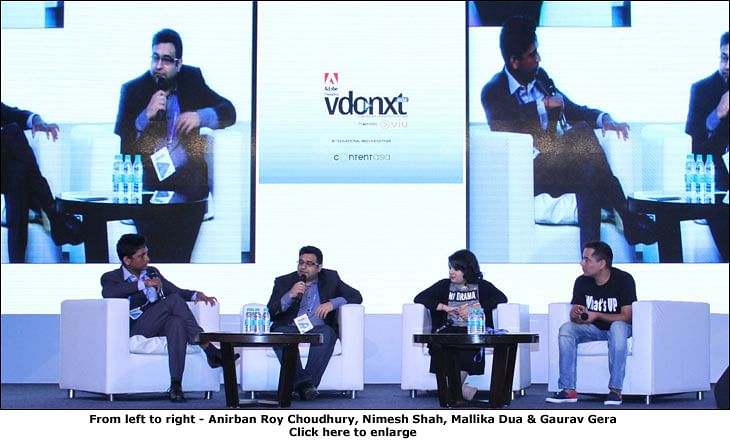/afaqs/media/post_attachments/12114e535fe29498b0095f10d0f2fd5f966a398128609ca42a6c38312f572afd.jpg)
Why is virality elusive? How does one catch it? Digital Expert Nimesh Shah quizzed online video artistes Mallika Dua and Gaurav Gera about this at vdonxt asia 2017 last week.
On day two of vdonxt asia 2017, the session comprising of panellists Nimesh Shah, head maven, director, co-founder, Wind Chimes along with Gaurav Gera, stand-up comedian and Mallika Dua, actor and comic discussed 'Why Is Virality Elusive?'. The session was moderated by Anirban Roy Choudhury of afaqs!.
/afaqs/media/post_attachments/d0230eebb4811b365704cf2a6cc5b24508bc4380c848268f13a6d3df6fff2d8b.jpg)
Choudhury started the session by asking Gera why it is so difficult to catch virality. Gera said, "I actually started making videos seven years ago and I wasn't getting that much success so in the year 2015 I started remaking the videos and I would think from the viewers' point of view. My videos were 5-7 minutes long and I found it boring to watch myself. So I thought I will make something that is easy to consume - something that's easy on the data, because I target youngsters who might have a tight budget for a data pack. So I made videos that were 15 seconds-long and the 'Chutki' story started. Then, two months later I made 'Shopkeeper and Chutki' and Chutki suddenly took off in April 2015." So he took feedback from his audiences based on the comments his videos received from viewers. He made videos that were not discussed on TV or films and decided to make something that was different to watch.
/afaqs/media/post_attachments/08374f047737b34bd2ca6c3257e5862c5b8b8533431931693576caa3fd511bf2.jpg)
Choudhury then asked Dua if she makes viral videos or videos that go viral. Dua said, "I make a video that goes viral. Viral is not a format. It is something that happens if the video is good or even if it is not good, it just happens to it. I never consciously tried to go viral in that sense; in fact, the first video I did, 'Shit People Say: Sarojini Nagar', was a very small scale video because I didn't think it would reach everyone." Then, BuzzFeed picked it up and the rest was history. This helped Dua realise how massive the digital medium actually is. "I think what worked for Gaurav and me was, when we made those short videos, we were already known for something else before that and we had people's attention," she concluded.

Choudhury asked Shah how virality is different for him from an agency point of view. Shah said, "It is strange that it is 2017 and the briefs still haven't changed. It is still about making a viral video. So, what we try and do is to find out why people watch certain films a lot more than the others. We tried to decode if these guys have created some wonderful content and have millions of subscribers and views and everything. If you try and slice it out there is some amount of loyalty to it, something that people were not accustomed to seeing earlier."
Today, it is not the cost of the film or how expensive it is or where you are going to shoot it that makes a difference but the uniqueness that you are injecting to it. Secondly, Shah felt that the sincerity of the video should also come through.
Shah added, "So when a brand comes to us and says 'Make us a video which a lot of people will watch', we try and understand what the video really stands for, what its values are, what it owns and how we can solve a problem using that piece of communication..."
Choudhury then asked the panelists if virality can be bought, to which Shah said, "Money really helps in buying fans and views but the larger question would be what is the intent? Is it just for snob value or do you really want people to watch your video?"
Dua then asked Shah if shares can also be bought, to which he replied, "Not really, but there are agencies that specialise in cultivating profiles... then these profiles are used in order to help you get a certain number of likes/shares because that agency is billing the client on the number of likes and shares that it gets. You have to realise what's genuine and what's not."
Choudhury along with the panelists came to the conclusion that virality can't be bought, one cannot make a viral video but can make a video that goes viral.
/afaqs/media/agency_attachments/2024-10-10t065829449z-afaqs_640x480.png)
 Follow Us
Follow Us